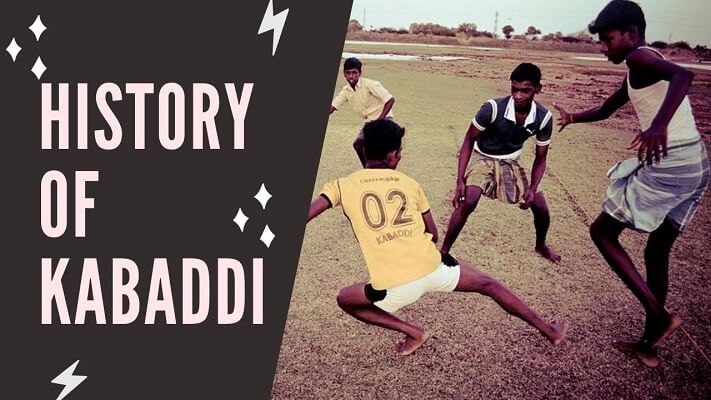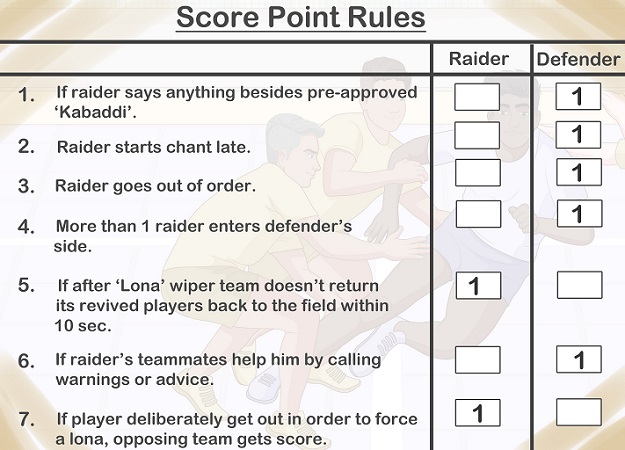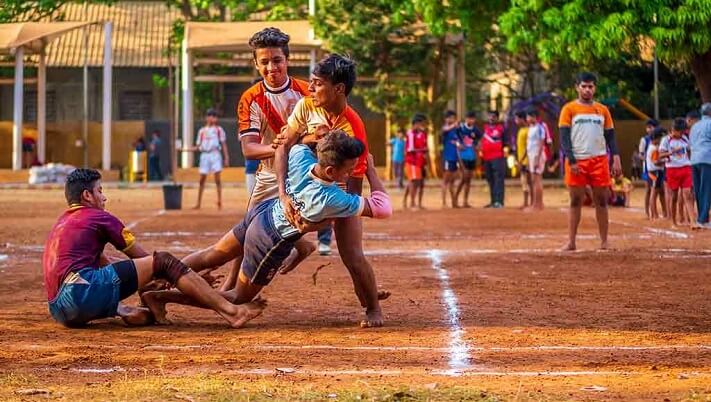|
Listen to this article
|
Kabaddi, often referred to as the “Game of the Masses,” holds a special place in the hearts of millions of Indians. This traditional sport, known for its blend of physical prowess, strategy, and sheer excitement, has captivated the nation for generations. In this article, we’ll delve into the rich history, rules, and the evolving world of online Kabaddi game. Don’t forget that there are 4ra Bet bonuses and promos waiting for you!
Kabaddi Game History
Kabaddi’s origins date back over 4,000 years, making it one of the oldest sports in the world. Initially played in ancient India, it was a means of showcasing the agility and strength of warriors. Over time, the history of Kabaddi game transformed into a sport for entertainment and community bonding.

Kabaddi’s journey through history is a fascinating one, as it evolved from a martial art and training exercise into a popular sport that embodies the spirit of India. Here’s a closer look at the various stages of its development:
- Ancient Roots: The earliest mention of Kabaddi can be traced back to ancient Indian scriptures and texts, such as the Mahabharata and the Ramayana, which describe it as a form of combat and exercise. It was primarily used by warriors to enhance their physical fitness and combat skills.
- Traditional and Regional Variations: As Kabaddi gained popularity, it began to take on regional variations across different parts of India. Each region put its own unique spin on the game, adapting it to suit the local culture and preferences. For example, Sanjeevani in Maharashtra, Gaminee in Bengal, and Hu-Tu-Tu in Punjab all had their distinct rules and styles.
- Standardization: In the early 20th century, efforts were made to standardize the rules of Kabaddi, making it more accessible as a sport. The first All India Kabaddi Tournament was held in 1923 in Punjab, marking a significant step towards unifying the game. During this period, Kabaddi began to be recognized as a competitive sport rather than just a pastime.
- National and International Recognition: Kabaddi’s popularity surged as it was incorporated into the Indian National Games in 1938. The All India Kabaddi Federation (AIKF) was established in 1950 to govern and promote the sport. Soon after, Kabaddi began to be played at the international level, with the first Asian Kabaddi Championship taking place in 1980.
- Inclusion in Multi-Sport Events: Kabaddi made its debut at the Asian Games in 1990 and has been a staple of the tournament ever since. It also found a place in the South Asian Games and, more recently, at the World Cup Kabaddi, showcasing its global reach and appeal.
- Modernization and Global Expansion: In the 21st century, Kabaddi underwent modernization efforts to make it more spectator-friendly and competitive. Leagues like the Pro Kabaddi League (PKL) emerged in India, attracting top talent and a growing fan base. This professional league format breathed new life into the sport and further globalized its reach.
Today, Kabaddi stands as a testament to the enduring spirit of Indian sportsmanship and tradition. Its rich history, deeply rooted in ancient culture and martial arts, has paved the way for a dynamic and thrilling sport enjoyed by millions around the world. From rural villages to modern arenas, Kabaddi continues to captivate hearts and minds, preserving its legacy while embracing the future of sports entertainment.

Kabaddi Game Rules
Here, let’s break down the core rules of Kabaddi in a handy table:
| Rule | Description |
|---|---|
| Number of Players | Each team consists of seven players on the court. |
| Court Dimensions | A rectangular court with a length of 13 meters and a width of 10 meters is used. |
| Playing Time | A standard Kabaddi match consists of two halves of 20 minutes each with a 5-minute halftime. |
| Raids | In a raid, a player from the attacking team crosses into the opponent’s half to tag as many defenders as possible while chanting “Kabaddi, Kabaddi.” |
| Defenders | Defenders aim to stop the raider by tackling or touching them. |
| Touch Points | A raider scores a point for each defender they successfully touch and return to their half. |
| Bonus Points | Bonus points are earned by a raider if they cross a specific line on the opponent’s side. |
| Super Raid | A raider can earn extra points by tagging three or more defenders in a single raid. |
| Super Tackle | Defenders can earn extra points by tackling a raider with three or fewer team members on the court. |
| Winning Team | The team with the most points at the end of the match wins. |
Rules Of Kabaddi Game In Hindi
| नियम | विवरण |
|---|---|
| खिलाड़ियों की संख्या | प्रत्येक टीम में कबड्डी खेल में सात खिलाड़ी होते हैं। |
| कोर्ट के आकार | कबड्डी कोर्ट का आकार 13 मीटर की लंबाई और 10 मीटर की चौड़ाई होती है। |
| खेल का समय | एक पारंपरिक कबड्डी मैच में दो अंश होते हैं, प्रत्येक अंश 20 मिनट का होता है, और इन दो अंशों के बीच 5 मिनट की आंतरिक पावस होती है। |
| रेड्स | एक रेडर एक और टीम के खिलाड़ियों को छूकर या टच करने के लिए प्रोत्साहित करने के लिए विपक्ष के आधे में प्रवेश करता है और उन्हें अधिक से अधिक छूकर अपने आधे में वापस आने का प्रयास करता है, “कबड्डी, कबड्डी” बोलते हुए। |
| रक्षक | रक्षक रेडर को रोकने के लिए उन्हें टैकल करके या छूकर उन्हें रोकने का प्रयास करते हैं। |
| टच पॉइंट्स | रेडर एक खिलाड़ी को सफलतापूर्वक छूकर अपने आधे में वापस लौटने पर पॉइंट प्राप्त करता है। |
| बोनस पॉइंट्स | बोनस पॉइंट्स रेडर उन्हें प्राप्त करते हैं अगर वे विपक्ष के ओर की ओर एक विशिष्ट रेखा पार करते हैं। |
| सुपर रेड | एक रेडर एक ही रेड में तीन या उससे अधिक रक्षकों को छूकर अधिक पॉइंट प्राप्त कर सकता है। |
| सुपर टैकल | रक्षक तीन या तीन से कम टीम सदस्यों के साथ एक रेडर को टैकल करके अतिरिक्त पॉइंट्स कमा सकते हैं। |
| विजयी टीम | मैच के अंत में अधिकांश पॉइंट्स वाली टीम विजयी होती है। |
Kabaddi Game Online
In recent years, Kabaddi has also found a new home online. With the advent of technology, fans can now enjoy the thrill of Kabaddi from the comfort of their homes. Online Kabaddi games and streaming platforms have become immensely popular, allowing enthusiasts from all over the world to witness the adrenaline-pumping action of this ancient sport.

Whether you’re a seasoned Kabaddi enthusiast or a newcomer to the game, the excitement and intrigue of Kabaddi continue to captivate audiences both on and off the court. Its rich history, intricate rules, and online presence make it a truly unique and fascinating part of India’s sporting heritage. So, the next time you hear the chant of “Kabaddi, Kabaddi,” you’ll know that you’re in for a spectacle that has endured through millennia and is here to stay in the modern era.
How Many Players Are There in Kabaddi Game?
In a standard game of Kabaddi, each team consists of seven players on the court at any given time. These seven players include both raiders and defenders who take on specific roles and responsibilities during the match. So, there are a total of 14 players on the field, with 7 players on each team, competing against each other in Kabaddi.
Skills Of The Game Kabaddi
Kabaddi is a sport that demands a unique set of skills from its players. To excel in Kabaddi, athletes need to develop and hone various physical, mental, and tactical abilities. Here are some of the key skills required in the game:
| Skill | Description |
|---|---|
| Raiding Skills: | |
| Speed | Raiders must be exceptionally fast to enter the opponent’s half, tag defenders, and return safely within a short time frame. |
| Agility | Agility is crucial for evading tackles and defenders’ attempts to grab the raider. |
| Balance | Maintaining balance while tagging opponents and avoiding tackles is crucial, especially when a raider is in the opponent’s territory. |
| Defensive Skills: | |
| Strength | Defenders need physical strength to stop a raider’s progress and bring them to the ground. |
| Timing | Timing is critical in Kabaddi. Defenders must execute tackles with precision to tag the raider before they cross the centerline. |
| Teamwork | Effective communication and coordination with teammates are vital for trapping and tackling the raider as a cohesive defensive unit. |
| Aerobic and Anaerobic Endurance: | |
| Aerobic and Anaerobic Endurance | Kabaddi demands both aerobic endurance for continuous movement and anaerobic endurance for explosive bursts of speed and power during raids and tackles. |
| Breathing Control: | |
| Breathing Control | Raiders, in particular, need to master controlled breathing techniques to chant “Kabaddi” continuously while raiding without taking a breath. |
| Mental Toughness: | |
| Mental Toughness | Kabaddi can be physically grueling and mentally demanding. Players must maintain focus, stay calm under pressure, and make split-second decisions. |
| Tactical Acumen: | |
| Tactical Acumen | Understanding opponent strategies, knowing when to attack, and when to play defensively are essential aspects of Kabaddi’s tactical dimension. |
| Footwork: | |
| Footwork | Quick and precise footwork helps both raiders and defenders in their respective roles. It allows raiders to escape tackles and defenders to position themselves effectively. |
| Communication: | |
| Communication | Effective communication within the team is crucial. Raiders need to signal to their teammates when they’ve tagged an opponent, and defenders must coordinate to trap raiders. |
| Hand-Eye Coordination: | |
| Hand-Eye Coordination | Accurate hand-eye coordination is essential for taggers to successfully touch opponents, especially in tight situations. |
| Decision-Making: | |
| Decision-Making | Players must make rapid decisions on whether to continue a raid, return to their half, or attempt a strategic move based on the situation on the court. |
| Strategy and Game Awareness: | |
| Strategy and Game Awareness | Understanding the state of the match, the score, and the time remaining is vital for both raiders and defenders to make informed decisions. |
| Physical Flexibility: | |
| Physical Flexibility | Flexibility helps players evade tackles, perform dives, and stretch to reach opponents during raids and tackles. |
In summary, Kabaddi is a sport that requires a unique blend of physical fitness, mental agility, and strategic thinking. Players must continually refine these skills through rigorous training and practice to excel in the fast-paced and dynamic world of Kabaddi.

Conclusion
In conclusion, Kabaddi is much more than just a sport; it is a vibrant tapestry woven with the threads of history, culture, and unbridled enthusiasm. Originating in the heart of India’s ancient traditions, this exhilarating game has transcended generations, evolving from a martial exercise to a global spectacle. With its unique blend of physical prowess, strategic brilliance, and a deep-rooted sense of teamwork, Kabaddi continues to mesmerize audiences both on and off the court.
As Kabaddi forges ahead into the modern era, it remains a powerful symbol of India’s sporting heritage and a testament to the enduring spirit of competition. With professional leagues, international tournaments, and a growing fanbase worldwide, the game’s future shines as brightly as its storied past. Kabaddi embodies the very essence of sportsmanship, resilience, and the unyielding spirit of athletes who strive for victory while respecting their opponents. It stands as a cultural treasure that not only unites communities but also transcends borders, showcasing the universal appeal of this remarkable sport.
How to Play Kabaddi Video Review
FAQ
Q: What is Kabaddi?
A: Kabaddi is a popular team sport that originated in India. It involves two teams, each trying to score points by sending a “raider” into the opponent’s half of the court to tag as many defenders as possible and return to their own half without being tackled.
Q: Kabaddi is the national game of which country?
A: Kabaddi is the national game of Bangladesh. In India, while Kabaddi is extremely popular, it is not officially designated as the national game.
Q: How many players are there on each team in a Kabaddi match?/How many players in Kabaddi game?
A: Each team in a Kabaddi match consists of seven players on the court at any given time.
Q: What are the basic rules of Kabaddi?
A: The basic rules of Kabaddi include tagging opponents to score points, defending against raiders, crossing the centerline during a raid, and adhering to a time limit for each raid.
Q: How is a Kabaddi match scored?
A: Teams score points in Kabaddi by tagging opponents during raids and preventing the opposing raider from returning to their half. The team with the most points at the end of the match wins.
Q: What are the different types of points in Kabaddi?
A: In Kabaddi, players can score “touch points” by tagging defenders and “bonus points” by crossing a specific line on the opponent’s side. There are also “super raid” and “super tackle” opportunities for earning extra points.
Q: When did Kabaddi gain international recognition?
A: Kabaddi gained international recognition in the late 20th century and was included in events such as the Asian Games. It has since expanded its presence on the global stage.
Q: Are there professional Kabaddi leagues?
A: Yes, there are professional Kabaddi leagues, such as the Pro Kabaddi League (PKL) in India, which has contributed significantly to the sport’s popularity and growth.
Q: Can I watch Kabaddi matches online?
A: Yes, many Kabaddi matches are available for viewing online through streaming platforms and official league websites, making it accessible to fans worldwide.
Q: Is Kabaddi played only in India?
A: While Kabaddi has deep roots in India, it is played in several other countries, and international competitions feature teams from various parts of the world.
Q: What makes Kabaddi unique among sports?
A: Kabaddi’s unique blend of physicality, strategy, and teamwork sets it apart. It requires quick thinking, agility, and the ability to adapt to rapidly changing situations, making it an exciting and dynamic sport.

I’m Johar, hailing from the vibrant nation of India. My journey into the realm of online sports betting began as a curiosity and quickly transformed into a passion. With a background in mathematics and a fascination for sports, I found myself naturally drawn to the world of odds, probabilities, and strategic wagering.
Through my articles, I aim to bridge the gap between the complexities of sports betting and the everyday bettor, offering insights, tips, and a deeper understanding of this thrilling pastime. My commitment lies not only in helping others make informed betting decisions but also in promoting responsible gambling practices within the diverse and dynamic landscape of Indian sports betting.
